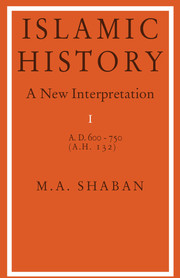Book contents
- Frontmatter
- Contents
- Acknowledgements
- Preface
- 1 The Islamic revolution in its environment
- 2 The emergence of Abū Bakr
- 3 ‘Umar and the conquests
- 4 The breakdown of the Madīnan regime
- 5 Mu‘āwiya and the second civil war
- 6 The age of Ḥajjāj
- 7 Moderate reform, radical reform and reaction: the reigns of Sulaymān, ‘Umar II and Yazīd II
- 8 Hishām: survival of the empire
- 9 The collapse of the Marwānids
- 10 The end of an era
- Works cited
- Index
8 - Hishām: survival of the empire
Published online by Cambridge University Press: 05 June 2012
- Frontmatter
- Contents
- Acknowledgements
- Preface
- 1 The Islamic revolution in its environment
- 2 The emergence of Abū Bakr
- 3 ‘Umar and the conquests
- 4 The breakdown of the Madīnan regime
- 5 Mu‘āwiya and the second civil war
- 6 The age of Ḥajjāj
- 7 Moderate reform, radical reform and reaction: the reigns of Sulaymān, ‘Umar II and Yazīd II
- 8 Hishām: survival of the empire
- 9 The collapse of the Marwānids
- 10 The end of an era
- Works cited
- Index
Summary
Hishām, the fourth son of ‘Abdulmalik to become Amīr al-Mu'minīn, promptly succeeded his brother Yazīd II. This smooth succession strongly indicates the complete victory of the expansionists and their determination to continue the ‘Abdulmalik-Ḥajjāj policies which had been successfully reimposed during the reign of Yazīd II. There is no doubt that this was Hishām's intention, although the circumstances of his reign forced him, at times, to deviate from these particular policies, and yield to the forces of assimilation. However, this deviation was only temporary, and once the impending danger receded Hishām dutifully reverted to implementing the expansionist policies to the full. It is a measure of his ability and dexterity as a statesman that he was able to survive as long as he did. In his long reign (724–43/105–25), Hishām was faced with the most serious threats on all frontiers of the empire. Internally, he ruled over a people with conflicting interests long divided against itself. While these internal conflicts were simmering, he had to use every resource at his command to save the empire itself from being torn apart by its external enemies. In this task he succeeded, but not even an absolute ruler, as capable as Hishām, could resist the tremendous pressure brought to bear on him by powerful sections of his subjects whose support he badly needed.
- Type
- Chapter
- Information
- Islamic HistoryA New Interpretation, pp. 138 - 152Publisher: Cambridge University PressPrint publication year: 1971



